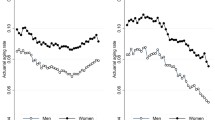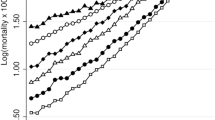Abstract
The compensation effect of mortality (CEM) was tested and species-specific lifespan was estimated using data on one-year age-specific death rates from the Human Mortality Database (HMD). CEM was confirmed using this source of the data and human species-specific lifespan estimates were obtained, which were similar to the estimates published before. Three models (Gompertz–Makeham, Gompertz–Makeham with mean-centered age, and Gompertz) produced similar estimates of the species-specific lifespan. These estimates demonstrated some increase over time. Attempts to measure aging rates through the Gompertz slope parameter led to the conclusion that actuarial aging rates were stable during most of the 20th century, but recently demonstrated an increase over time in the majority (74%) of studied populations. This recent phenomenon is most likely caused by more rapid historical decline of mortality at the younger adult age groups compared to the older age groups, thus making the age gradient in mortality steeper over time. There is no biomedical reason to believe that human aging rates accelerated recently, so that the actuarial aging rate is probably not a good measure of true aging rate (rate of functional loss). Therefore, better measures of aging rate need to be developed.



Similar content being viewed by others
References
Gavrilov, L. A., and Gavrilova, N. S. (1991) The Biology of Life Span: A Quantitative Approach, Harwood Academic Publisher, New York.
Gavrilov, L. A., and Gavrilova, N. S. (2006) Reliability Theory of Aging and Longevity, in Handbook of the Biology of Aging (Masoro, E. J., and Austad, S. N. eds) 6 Edn., Academic Press, San Diego, pp. 3-42.
Hawkes, K., Smith, K. R., and Blevins, J. K. (2012) Human actuarial aging increases faster when background death rates are lower: a consequence of differential heterogeneity? Evolution, 66, 103-114, https://doi.org/10.1111/j.1558-5646.2011.01414.x.
Strehler, B. L., and Mildvan, A. S. (1960) General theory of mortality and aging, Science, 132, 14-21, https://doi.org/10.1126/science.132.3418.14.
Gavrilov, L. A. (1984) Does the limit of the life-span really exist? Biofizika, 29, 908-909.
Le Bras, H. (1976) Mortality laws and limited age, Population, 31, 655-692.
Golubev, A. (2019) A 2D analysis of correlations between the parameters of the Gompertz-Makeham model (or law?) of relationships between aging, mortality, and longevity, Biogerontology, 20, 799-821, https://doi.org/10.1007/s10522-019-09828-z.
Burger, O., and Missov, T. I. (2016) Evolutionary theory of ageing and the problem of correlated Gompertz parameters, J. Theor. Biol., 408, 34-41, https://doi.org/10.1016/j.jtbi.2016.08.002.
Li, T., and Anderson, J. J. (2015) The Strehler-Mildvan correlation from the perspective of a two-process vitality model, Popul. Stud., 69, 91-104, https://doi.org/10.1080/00324728.2014.992358.
Yashin, A. I., Ukraintseva, S. V., Boiko, S. I., and Arbeev, K. G. (2002) Individual aging and mortality rate: how are they related? Soc. Biol., 49, 206-217, https://doi.org/10.1080/19485565.2002.9989059.
Li, T., Yang, Y. C., and Anderson, J. J. (2013) Mortality increase in late-middle and early-old age: heterogeneity in death processes as a new explanation, Demography, 50, 1563-1591, https://doi.org/10.1007/s13524-013-0222-4.
Yashin, A. I., Begun, A. S., Boiko, S. I., Ukraintseva, S. V., and Oeppen, J. (2002) New age patterns of survival improvement in Sweden: do they characterize changes in individual aging? Mech. Ageing Dev., 123, 637-647, https://doi.org/10.1016/s0047-6374(01)00410-9.
Golubev, A. (2004) Does Makeham make sense? Biogerontology, 5, 159-167, https://doi.org/10.1023/B:BGEN.0000031153.63563.58.
Tai, T. H., and Noymer, A. (2018) Models for estimating empirical Gompertz mortality: with an application to evolution of the Gompertzian slope, Popul. Ecol., 60, 171-184, https://doi.org/10.1007/s10144-018-0609-6.
Yashin, A. I., Begun, A. S., Boiko, S. I., Ukraintseva, S. V., and Oeppen, J. (2001) The new trends in survival improvement require a revision of traditional gerontological concepts, Exp. Gerontol., 37, 157-167, https://doi.org/10.1016/s0531-5565(01)00154-1.
Bongaarts, J. (2009) Trends in senescent life expectancy, Popul. Stud., 63, 203-213, https://doi.org/10.1080/00324720903165456.
Gavrilov, L. A., Gavrilova, N. S., and Yaguzhinsky, L. S. (1978) The main patterns of aging and death of animals from the point of view of the theory of reliability [in Russian], J. Gen. Biol., 39, 734-742.
Bongaarts, J. (2005) Long-range trends in adult mortality: Models and projection methods, Demography, 42, 23-49, https://doi.org/10.1353/dem.2005.0003.
Missov, T. I., Lenart, A., Nemeth, L., Canudas-Romo, V., and Vaupel, J. (2015) The Gompertz force of mortality in terms of the modal age at death, Demogr. Res., 32, 1031-1047, https://doi.org/10.4054/DemRes.2015.32.36.
Wilmoth, J. R., and Horiuchi, S. (1999) Rectangularization revisited: variability of age at death within human populations, Demography, 36, 475-495, https://doi.org/10.2307/2648085.
Velilla, S. (2018) A note on collinearity diagnostics and centering, Am. Stat., 72, 140-146, https://doi.org/10.1080/00031305.2016.1264312.
Wood, F. S. (1984) Comment: effect of centering on collinearity and interpretation of the constant, Am. Stat., 38, 88-90, https://doi.org/10.1080/00031305.1984.10483173.
Tarkhov, A. E., Menshikov, L. I., and Fedichev, P. O. (2017) Strehler-Mildvan correlation is a degenerate manifold of Gompertz fit, J. Theor. Biol., 416, 180-189, https://doi.org/10.1016/j.jtbi.2017.01.017.
URL: Human Mortality Database. University of California, Berkeley (USA), Available at https://www.mortality.org/ (retrieved on 6.5.2022).
Gavrilov, L. A., Gavrilova, N. S., and Nosov, V. N. (1983) Human life span stopped increasing: why? Gerontology, 29, 176-180, https://doi.org/10.1159/000213111.
Drefahl, S., Lundstrom, H., Modig, K., and Ahlbom, A. (2012) The era of centenarians: mortality of the oldest old in Sweden, J. Intern. Med., 272, 100-102, https://doi.org/10.1111/j.1365-2796.2012.02518.x.
Gavrilov, L. A., Gavrilova, N. S., and Krut’ko, V. N. (2017) The future of human longevity, Gerontology, 63, 524-526, https://doi.org/10.1159/000477965.
Robine, J. M., and Cubaynes, S. (2017) Worldwide demography of centenarians, Mech. Ageing Dev., 165, 59-67, https://doi.org/10.1016/j.mad.2017.1003.1004.
Tuljapurkar, S., Li, N., and Boe, C. (2000) A universal pattern of mortality decline in the G7 countries, Nature, 405, 789-792, https://doi.org/10.1038/35015561.
Gavrilov, L. A., and Gavrilova, N. S. (2020) What can we learn about aging and COVID-19 by studying mortality? Biochemistry (Moscow), 85, 1499-1504, https://doi.org/10.1134/S0006297920120032.
Skulachev, V. P., Shilovsky, G. A., Putyatina, T. S., Popov, N. A., Markov, A. V., Skulachev, M. V., and Sadovnichii, V. A. (2020) Perspectives of Homo sapiens lifespan extension: focus on external or internal resources? Aging, 12, 5566-5584, https://doi.org/10.18632/aging.102981.
Acknowledgments
We would like to thank the anonymous journal referees for very constructive comments.
Funding
This work was partially financially supported by the National Institutes of Health (project no. NIH R21AG054849).
Author information
Authors and Affiliations
Contributions
L.G. designed the study, analyzed and interpreted results, edited the manuscript. N.G. conducted statistical analyses and prepared the manuscript.
Corresponding author
Ethics declarations
The authors declare no conflict of interest in financial or any other sphere. This article does not contain any studies with human participants or animals performed by any of the authors.
Rights and permissions
About this article
Cite this article
Gavrilov, L.A., Gavrilova, N.S. Trends in Human Species-Specific Lifespan and Actuarial Aging Rate. Biochemistry Moscow 87, 1622–1633 (2022). https://doi.org/10.1134/S0006297922120173
Received:
Revised:
Accepted:
Published:
Issue Date:
DOI: https://doi.org/10.1134/S0006297922120173




